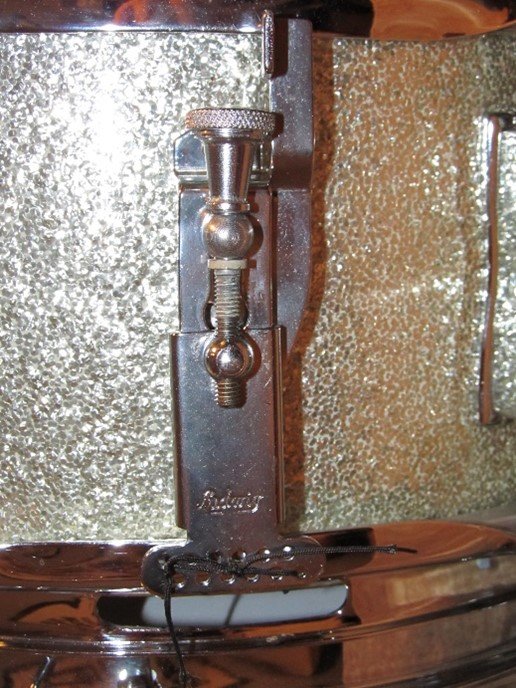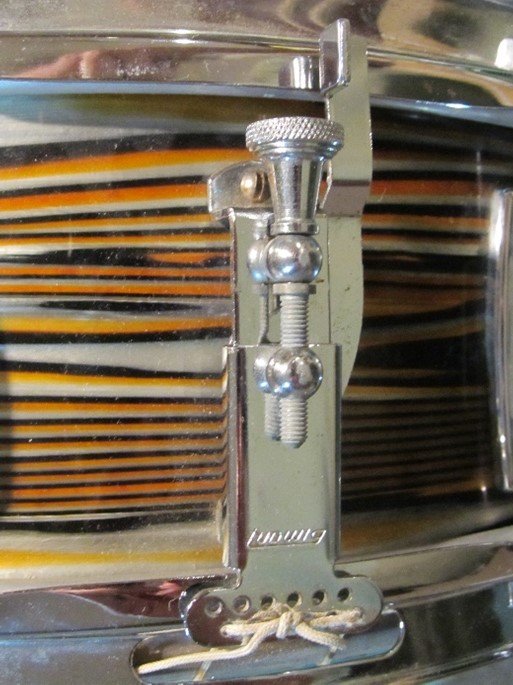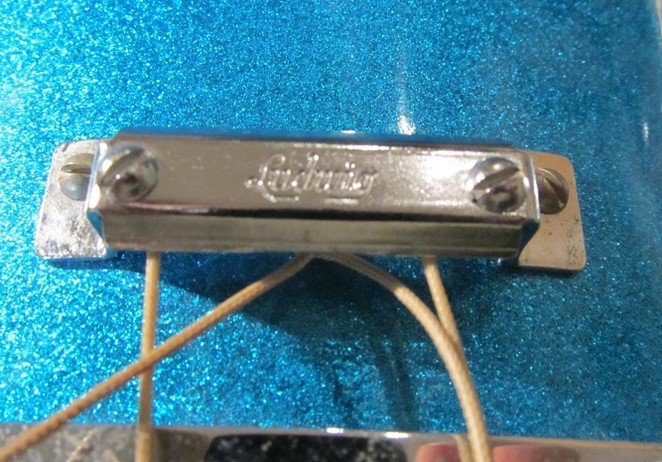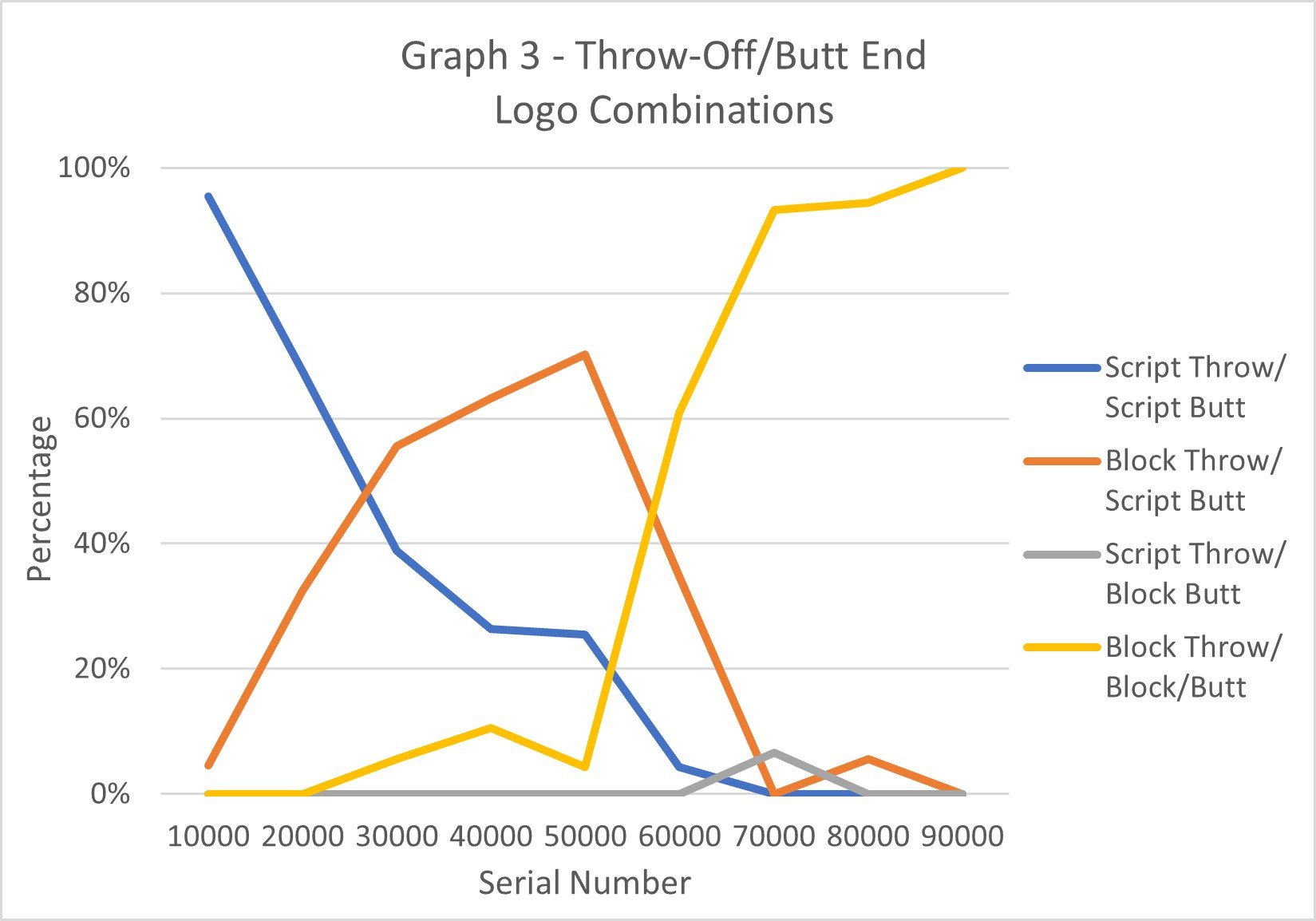The goal of this study is to provide accurate information to assist vintage drum collectors to better evaluate the authenticity of Ludwig Standard snare drums by delving deeply into the specifics of when different logos appear on the P-83 model throw-offs and P-32 model butt ends.
Background on Ludwig Standards:
Ludwig employed the name “Standard” multiple times, beginning with snare drums in the 1920s and continuing through the Standard Line™ drums of the 1980s. This study focuses on the Ludwig Standard drums offered as a second-tier line from 1968 until about 1973 or 1974. Once largely overlooked by collectors, Ludwig Standards have grown in popularity in recent years. Unfortunately, few have written in detail about them, so reliable information is scarce.[1]
P-83 Model Throw-offs:
Factory original Ludwig Standard snare drums almost exclusively[2] possess P-83 model throw-offs. When Ludwig introduced the Standard in 1968, the P-83 throw-offs exhibited a Script logo (Figure 1). This is the same Script logo P-83 used on Ludwig’s main line snare drums since the early 1960s. After a while, the Script logo P-83 phases out and the Block logo P-83 replaces it (Figure 2). The switch was not immediate or absolute. The transition point is somewhat blurred by two factors: the non-sequential use of serial numbers which makes accurate dating problematic and the ease and popularity of swapping original throw-offs for non-original replacements which impacts the accuracy of data collected decades later. Viewed as less collectible and less valuable, Standard snare drums frequently became donors for main line snare drums which needed replacement throw-offs.
Script Logo Throw-Off (left) and Block Logo Throw-Off (right)
A look at the Ludwig Standard catalogs does not provide any meaningful insight as to when the switch occurs. The P-83 throw-off is visible on all the snare drums shown in Standard Catalog 1 (circa 1968), but almost all the pictures are too small to read the logo. Only one logo is discernable – a Script version of the logo is pictured on page 9. Many of the same images are used for the Standard Catalog S-2 (circa 1969/70). Again, only one of the logos can be determined. A Script logo is shown on page 9, but it is likely that the same picture appears in both catalogs.
P-32 Model Butt Ends:
Meanwhile, complimenting the P-83 throw-off on Ludwig Standard snare drums is the P-32 model butt end. At its introduction in 1968, the Ludwig Standard snare drum is equipped with the Script logo version of the P-32 (Figure 3). As with the P-83 throw-off, there was a transition from the Script logo and the Block logo versions of the P-32 butt end (Figure 4). Interestingly, this switch of logos on the butt ends did not happen at the same time the logo switches on the throw-offs. This timing is explored in this study. Replacement of butt ends is much less common than replacement of throw-offs. P-32 model butt ends are static and less likely to wear out. It also seems less likely that a P-32 butt end would be harvested from a Standard snare drum than a P-83 throw-off. Therefore, the butt ends present on Standard snare drums today seem more likely to be original parts. A review of Standard catalogs is not enlightening because no butt ends are pictured.
Script Logo Butt End (left) and Block Logo Butt End (right)
Throw-off / Butt End Logo Combinations:
Three combinations of logos appear frequently on throw-offs/butt ends on Ludwig Standard snare drums. What started as a throw-off/butt end pair with both having Script logos changed to a pairing of a Block logo throw-off and a Script logo butt end. The combination of a Block logo throw-off and a Block logo butt end followed and finished out the run of Ludwig Standards. The combination of a Script logo throw-off and a Block logo butt end is uncommon. The transitions between the pairings correspond to the change of logos on each the throw-off and the butt end. The transitions are also not immediate or absolute. With two variables changing, greater variation is evident than when only the throw-off or butt end is considered. Exchange or replacement of throw-offs and butt ends may blur the lines further.
Study Approach:
Over the last ten years I have compiled a list of information from 1,237 different Ludwig Standard drums. Some information is directly reported by vintage drum enthusiasts, but most of the information is gathered from online resources including eBay, Reverb, Drumforum.org and VintageDrumForum.com. I am not always able to gather every detail from every drum, either because the drums have missing or replaced parts, necessary information is lacking, or insufficient pictures are provided. The originality of any vintage drum 40-50 years after its manufacture is always an issue. Some modifications are easily detected while others may not be identified. For example, if a Script logo P-83 throw-off is traded for a Block logo P-83 throw-off, that switch is not detected. This may impact the integrity of the data used for this study and may explain some of the outliers and exceptions in the results.
Part I of this study links the types of logos to the serial numbers on the associated badges. Of the 1,237 Ludwig Standards on the list, 551 are snare drums. The list of 551 snare drums is reduced to the 333 which possess serial numbers and information about the logos on a P-83 throw-off, a P-32 butt end or both. This pared down list of 333 snare drums is the basis for Part I of this study. Of these, the type of logo is known for 295 of the throw-offs and 232 of the butt ends. This is largely because online listings show more picture of throw-offs than butt ends. One hundred and ninety-five drums had information about the logos on both the throw-off and the butt end available. Further, information from fifteen drums with badges which did not possess serial numbers (referred to as “Blank Badges”) is included because these drums can be grouped with the drums with serial numbers based upon their date stamps.
For Part 2 of this study, the list of 551 Ludwig Standard snare drums identified above is pared down to only drums possessing date stamps or Date Codes and information about the P-83 throw-off, P-32 butt end or both. This results in a much smaller list consisting of 68 drums with date stamps (at least month and year must be readable) and 18 with Date Codes. For those unfamiliar with Date Codes, that term refers to four and five-digit numbers stamped or handwritten onto the line provided for a date on paper labels inside drums in the 1971/72 time period. Based upon prior research of Date Codes, they can be reliably grouped into those which appear in 1971 and those which appear in 1972.[3] Because serial numbers are highly correlated with manufacture dates, but not exact surrogates for them, use of date stamps and Date Codes in Part 2 of this study provides more precisely dated information than serial numbers. However, the limitation to using date stamps and Date Codes is the relatively small number of drums which have them and that they were not in use during the entire six to seven years production of Ludwig Standards. Ludwig discontinues date stamping its drums at about the end of 1971 and Date Codes appear for about one year from mid-1971 through early 1972. Utilizing two different approaches (serial numbers and date indicators) to the question of when each logo appeared on the throw-off and butt end provides additional insight.
Study Results – Part 1:
Data from 333 Ludwig Standard snare drums with P-83 throw-offs, P-32 butt ends, or both are utilized, grouped by sets of 10,000 serial numbers, with the sole drum with a serial number above 90000 included with the 80001-90000 group and fifteen drums with Blank badges included with the 40000-50000 group. Table 1 and Graphs 1 and 2 present the data for throw-offs and butt ends for drums with serial numbers.
While both the throw-off and the butt end initially have the Script logo, the majority of the throw-offs change from Script to Block logos by about serial number 30000. For the butt end, it occurs at about serial number 60000. The transition from Script to Block logos is fairly immediate and permanent for both throw-offs and butt ends. Table 2 and Graph 3 present the data for the combination of throw-offs and butt ends for drums with serial numbers.
The logos on the throw-off and butt end change from Script to Block as serial numbers grow. Although the changes are neither immediate or absolute, the approximate change in logos from Script to Block occurs between serial numbers 20000 and 30000 for throw-offs and between serial numbers 50000 and 60000 for butt ends. These serial number ranges are approximate. Some variation is expected, but it is difficult to determine how much of this variation is from factory installed parts and how much is from post-factory modifications. There are three typical combinations of logos for throw-off/butt ends, which appear in the same serial number ranges.
The Ludwig Standard snare drum starts with a Script logo throw-off/Script logo butt end combination. By about serial number 30000, the most frequently reported combination is Block logo throw-off/Script logo butt end. This combination is never highly dominant, as some Script logo throw-offs and some Block logo butt ends are seen between 30000 and 60000. By about serial number 60000, the most frequently reported combination is Block logo throw-off and block log butt end. One drum is reported with a Script logo throw-off and a Block logo butt end – this could involve replaced parts or could just be an anomaly.
Study Results – Part 2:
Data from 68 Ludwig Standard snare drums with date stamps and P-83 throw-offs, P-32 butt ends, or both are utilized. Blank badges with date stamps or Date Codes fit into this part 2 of the study without modifications. When known, the logo design present on each throw-off and butt end is indicated. Information from eighteen drums with Date Codes and P-83 throw-offs, P-32 butt ends, or both are also shown. To permit combining the information from drums with date stamps with the drums with Date Codes, information is presented by year. Table 3 presents the data for throw-offs and butt ends for drums with date stamps.
While both the throw-off and the butt end initially have the Script logo, the majority of the logos change from Script to Block by about 1970 on the throw-off and about 1971 on the butt end. The transition from Script to Block logos is fairly immediate and permanent for both throw-offs and butt ends. Table 4 presents the data for the combination of throw-offs and butt ends for drums with date stamps.
Tables 5 and 6 presents the data for throw-offs and butt ends and their combinations for drums with Date Codes.
Tables 7 and 8 and Graphs 4, 5 and 6 combine the data from Tables 3-6 for throw-offs and butt ends and their combinations for drums with date stamps and Date Codes.
Results/Conclusions:
The logos on the throw-off and butt end change from Script to Block as serial numbers grow and time passes. Although the changes are neither immediate or absolute, the approximate change in logos from Script to Block occurs between serial numbers 20000 and 30000 (mid-1969/early 1970) for throw-offs and between serial numbers 50000 and 60000 (mid-1971) for butt ends. These serial number and date ranges are approximate. Some variation is expected, but it is difficult to determine how much of this variation is from factory installed parts and how much is from post-factory modifications. There are three typical combinations of logos for throw-off/butt ends, which appear in the same ranges.
The Ludwig Standard snare drum starts with a Script logo throw-off/Script logo butt end combination. By about serial number 30000 (early 1970), the most frequently reported combination is Block logo throw-off/Script logo butt end. This combination is never highly dominant, as some Script logo throw-offs and some Block logo butt ends are seen between 30000 and 60000. By about serial number 60000 (mid-1971), the most frequently reported combination is Block logo throw-off and block log butt end. Table 9 summarizes the timing of the changes in logos on Ludwig Standard throw-offs and butt ends.
[1] David Anfuso added Ludwig Standard catalog pages to the Vintage Drum Guide in July 2009. (http://www.vintagedrumguide.com/ludwig_standards.htm). I developed and published a dating guide in 2013. (Richard E. Gier, Serial Number Based Dating Guides for Ludwig Drums, Rebeats Publications, 2013). Mark Jeffs authored a short article published on October 31, 2018, available on www.mikedolbear.com. (http://mikedolbear.com/vintage-view/ludwig-standard-series/). Others have shared information about their individual drum sets on Not So Modern Drummer. (https://www.notsomoderndrummer.com/not-so-modern-drummer/2016/3/17/3zkcqhtgp4ns5lln2d2mtloy7l7x6e & https://www.notsomoderndrummer.com/not-so-modern-drummer/2021/4/28/4iazj2fykh1xt6946ppswahcc74i8q). Numerous threads about Ludwig Standards are available on www.drumforum.org and www.vintagedrumforum.com. Numerous opinions can be found on various Facebook groups about vintage drums in general and Ludwig Standards in particular.
[2] I say “almost exclusively” only because I know better than to speak in absolutes when discussing vintage drums. Also, some drums appear today with non-P-83 throw-offs and I cannot say for sure how these left the factory as I was not there. However, this is remarkably close to being an absolute. Of the 551 Standard snare drums documented, the throw-off type is known for 463. Of these, 404 had P-83s and 59 had something else. Fifty-seven of the fifty-nine which did not have P-83 throw-offs had a throw-off which was either not made by Ludwig or was not available until after the drums were manufactured. Only two reports of Ludwig Standard snare drums with a black-faced, block logo, 12-hole P-85 throw-off with a short throw arm (this was the version used on main line drums at the time) have been confirmed. The same mounting hole spacing permits easy swapping of P-83 throw-offs with other non-Ludwig and Ludwig throw-offs. Such swaps are seen with some frequency as demonstrated by more than 10% of those involved in this study having switched throw-offs. I contend that this is the most logical explanation for the existence of non-P-83 throw-offs on Ludwig Standard snare drums. Although it is possible that some Ludwig Standard snare drums came from the factory with different throw-offs, they are treated as replacement throw-offs for this study.
[3] Richard E. Gier, “Ludwig's Use of Paper Labels in 1971/1972 - Date Stamps and Date Codes,” August 31, 2020, available at http://www.gretschdrumdatingguide.com/other-projects.html (Project 5) and https://www.notsomoderndrummer.com/not-so-modern-drummer/2020/8/29/ludwigs-use-of-paper-labels-in-19711972-date-stamps-and-date-codes.



















